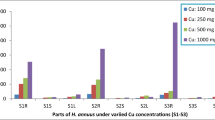Abstract
Phytoremediation is emerging as a potential cost-effective solution for remediation of contaminated soils, and bioavailability of metal in the soil for plant uptake is an important factor for successful phytoremediation. This study aimed at investigating the ability of EDTA and citric acid for enhancing soil bioavailability of Cu and phytoremediation by Elsholtzia splendens in two types of soils contaminated with heavy metals [i.e. mined soil from copper mining area (MS), and paddy soil (PS) polluted by copper refining]. The results showed that addition of 2.5 mmol/kg EDTA significantly increased the H2O extractable Cu concentration from 1.20 to 15.78 mg/kg in MS and from 0.26 to 15.72 mg/kg in PS, and that shoot Cu concentration increased 4-fold and 8-fold as compared to the control. There was no significant difference between the treatment with 5.0 mmol/kg EDTA and that with 2.5 mmol/kg EDTA, probably because that 2.5 mmol/kg EDTA was enough for elevating Cu bioavailability to the maximum level. As compared with the control, citric acid had no marked effect on both soil extractable Cu and shoot Cu concentration or accumulation. The results indicated that EDTA addition can increase the potential and efficiency of Cu phytoextraction byE. splendens in polluted soils.
Similar content being viewed by others
References
Blaylock, M., Salt, D.E., Dushenkov, S., Zakharova, O., Gussman, C., Kapulnik, Y., Ensley, B.D., Raskin, I., 1997. Enhanced accumulation of Pb in Indian Mustard by soil-applied chelating agents.Environ. Sci. Technol.,31:860–865.
Brooks, R.R., Reeves, R.D., Morrison, R.S., Malaisse, F., 1980. Hyperaccumulation of copper and cobalt a review.Bulletin de la Societie royale de Belgique,113:166–172.
Chaney, R.L., Malik, M., Li, Y.M., Brown, S.L., Brewer, E.P., Angle, J.S., Baker, A.J., 1997. Phytoremediation of soil metals.Curr. Opin. Biotechnol.,8:279–284.
Cunningham, S.D., Shann, J.R., Crowley, D.E., Anderson, T.A., 1997. Phytoremediation of contaminated water and soil.J. Environ. Qual.,28:760–766.
Deram, A., Petit, D., Robinson, B., Brooks, R., Gregg, P., Van-Halluwyn, C., 2000. Natural and induced heavy-metal accumulation byArrhenatherum elatius: implications for phytoremediation.Commun. Soil Sci. Plant Anal.,31:413–421.
Ernst, W.H.O., 1996. Bioavailability of heavy metal and decontamination of soils by plants.Applied geochemistry,11(1–2):163–167.
Grěman, H., Velikonja-Bolta, Š., Vodnik, D., Kos, B., Leštan, D., 2001. EDTA enhanced heavy metal phytoextraction: metal accumulation, leaching and toxicity.Plant soil,235:105–114.
Huang, J.W., Cunningham, S.D., 1996. Lead phytoextraction: species variation in lead uptake and translocation.New phytol.,134:75–84.
Jiang, L.Y., Ye, H.B., Yang, X.E., Shi, W.Y., Jiang, Y.G., 2002. Effect of copper refining on spatial distribution of heavy metal in surrounding soils and crops.J. Zhejiang Unv. (Agric & Life Sci.),28(6):689–693 (in Chinese)
Ke, W.S., **, H.A., Yang, Y., Wang, W.X., Chen, S.J., 2001. Analysis on characteristics of phytogeochemistry ofElsholtzia haichowensis in Daye Tonglushan copper mine.Acta ecologica sinica,6:907–912 (in Chinese).
Krishnamurti, G.S.R., Huang, P.M., Van Rees, K.C.J., 1997. Kinetics of cadmium release from soils as influenced by organic: implications in cadmium availability.J. Environ. Qual.,26(1):271–277.
Marschner, H., 1995. Mineral Nutrition of Higher Plants. 2nd Ed, Academic Press, London.
Mench, M., Martin, E., 1991. Mobilization of cadmium and other metals from two soils by root exudates of Zea mays L., Nicotiana tabacum L., and Nicotiana rustica L.Plant soil,132(2):187–196.
MAFF (Ministry of Agriculture Fisheries and Food), 1986. The analysis of agricultural materials. HMSO, London.
Raskin, I., Smith, R.D., Salt, D.E., 1997. Phytoremediation of metals: using plants to remove pollutants from the environment.Curr. Opin. Biotechnol.,8:221–226.
Salt, D.E., Smith, R.D., Raskin, I., 1998. Phytormediation.Annual Rev. Plant Physiol. Plant Mol. Biol.,49:643–668.
Schramel, O., Michalke, B., Kettrup, A., 2000. Study of the copper distribution in contaminated soils of hop fields by single and sequential extraction procedures.The Science of the Total Environment,263:11–22.
Smith, R.M., Martell, A.E., Motekaitis, R.J., 1995. NIST Critical Selected Stability constants of Metal Complexes Database. Department of Commerce, U.S.A.
Song, J., 2002. Assessment of Phytoavailability of Soil Metals and Phytoremediation of Soils Contaminated with Copper. Ph.D Thesis, Soil Sci Res. Institute. Chinese Academica Sinica, p.75–83 (in Chinese).
SSICA (Soil Sci. Ch. Acad.), 1980. Physical and Chemical Analyses of Soils. Shanghai Academic Press, Shanghai (in Chinese).
Tang, S.R., Wilke, B.M., Huang, C.Y., 1999. The uptake of copper by plants dominantly growing on copper mining spoils along the Yangtze River, the People's Republic of China.Plant soil,209:225–232.
Tang, S.R., Wilke, B.M., Brooks, R.R., 2001. Heavy-metal uptake by metal tolerantElsholtzia haichowensis andCommelina communis from china.Commun. Soil Sci. Plant Anal.,32(5–6):895–905.
Wu, L.H., Luo, Y.M., Christie, P., Wong, M.H., 2003. Effects of EDTA and low molecular weight organic acids on soil solution properties of a heavy metal polluted soil.Chemosphere,50:819–822.
**e, X.J., Xu, B.L., 1953. OnElsholtzia haichowensis: an indicator plant for copper.Bull. Geol. Soc. China,32(4):360–367 (in Chinese).
Yang, X.E., Shi, W.Y., Fu, C.X., Yang, M.J., 1998. Copper-hyperaccumulators of Chinese Native Plants: Characteristics and Possible Use for Phyto-remediation.In: Bassam, N.E.L., (Eds.), Sustainable Agriculture for Food, Energy and Industry. James and James Publishers, London, p.484–489.
Yang, M.J., Yang, X.E., Römheld, V., 2002. Growth and nutrient composition ofElsholtzia splendens Nakai under copper toxicity.J. Plant Nutr.,25(7):1359–1375.
Author information
Authors and Affiliations
Corresponding author
Additional information
Project supported by the National Natural Science Foundation of China (No. 29977017) and the Science and Technology Ministry of China (No. 2002CB410804)
Rights and permissions
About this article
Cite this article
Jiang, Ly., Yang, Xe. Chelators effect on soil Cu extractability and uptake byElsholtzia splendens. J. Zheijang Univ.-Sci. 5, 450–456 (2004). https://doi.org/10.1631/jzus.2004.0450
Received:
Accepted:
Published:
Issue Date:
DOI: https://doi.org/10.1631/jzus.2004.0450




